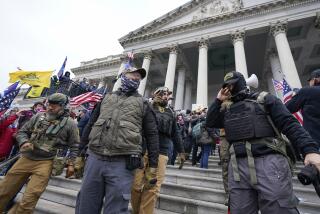Testing students’ knowledge of the civil rights movement
“Students’ Knowledge of Civil Rights History Has Deteriorated,” one headline announced. “Civil Rights Movement Education ‘Dismal’ in American Schools,” declared another.
The alarming headlines, which appeared in newspapers across the country, grew out of a report released three weeks ago by the Southern Poverty Law Center, “Teaching the Movement,” which claims that the civil rights movement is widely ignored in history classrooms. By not teaching it, the report claims, American education is “failing in its responsibility to educate its citizens to be agents of change.” The study included a report card for individual states, and California got slapped with a big fat F.
But is it true? Are today’s students really not learning about such an important part of U.S. history? The Southern Poverty Law Center has done groundbreaking work in combating racism and prejudice. But its new study simply doesn’t stand up.
For starters, the report did not base its conclusions on any direct testing of student knowledge. Not a single student, not a single teacher, not a single principal answered a single question about their knowledge for this report. The closest we get to a live child — and even this is a stretch — comes from Julian Bond, who wrote the report’s forward. Bond recounts that “some years ago” he gave a quiz to college students and found that none could identify George Wallace.
The report’s writers turned to a proven recipe in our crisis-addicted society. First, they gathered up standards documents from all 50 states laying out what students at each grade level should study; then they conducted a “content analysis” to determine what’s in these documents; next they landed a marquee figure to endorse the report; and finally, they invoked terms of impending doom and handed the final report to the PR department.
Had the report’s writers bothered to talk to real kids, they might have found something closer to what we found in a national survey of 2,000 high school students, reported in the March 2008 Journal of American History. We gave students a blank sheet and asked them to write down the names of figures from “Columbus to the present day” who are the “most famous Americans in history, not including presidents or first ladies.”
Surprisingly, teens rarely put down rock stars or sports idols for top picks. Instead, they listed legitimate historical figures such as Benjamin Franklin, Susan B. Anthony, Thomas Edison and Amelia Earhart. Three names, however, dominated the lists, appearing more often than any other heroes in U.S. history. Each of these figures comes straight from the civil rights movement: Martin Luther King Jr. (appearing on 67% of all lists), Rosa Parks (60%) and Harriet Tubman (44%).
The only actual evidence of students’ ignorance produced by “Teaching the Movement” comes not from the report but from the National Assessment of Educational Progress history exam, released in June, which found that “only 2% of high school seniors in 2010 could answer a simple question about the U.S. Supreme Court’s landmark Brown v. Board of Education decision.”
If this is right, we should be alarmed. But put yourself in the place of a kid taking a 50-minute test with 159 multiple-choice and short-answer questions. You hit a question containing the phrase “in the field of public education separate but equal has no place” and are asked to “describe the conditions that this 1954 decision was designed to correct.” Here’s a sample response: “The Brown girl had to walk past the white school every day to get to her ‘equal’ black school. Her father took the issue to court — separate but equal is not really equal.”
Not too shabby, right?
Sorry. According to NAEP scorers, the answer is denied full credit because “it does not say that the Brown case was meant to desegregate schools specifically.” Yet, if students are so dumb about Brown, how do we explain this finding: When given a multiple-choice question about which decision Brown overturned, 51% correctly chose Plessy v. Ferguson.
When the sky is falling, headlines reading “Majority of American Students Successfully Identify Important Court Ruling” won’t do it. Nor would it do to mention that the NAEP’s U.S. History Framework includes civil rights as a theme at all levels of instruction.
I agree with “Teaching the Movement” that students should learn more about civil rights. While they’re at it, have them learn more about the Constitutional Convention, the establishment clause, the Kansas-Nebraska Act, the waves of immigration in the 1890s, the New Deal and a host of other topics. Sadly, under No Child Left Behind, history has been pushed to the side in many schools.
But we don’t fix this by cooking up reports that smear students when not a single one of them was queried.
That’s not research. It’s libel.
Sam Wineburg is a professor of education and history at Stanford University and the author of “Historical Thinking and Other Unnatural Acts.”
More to Read
A cure for the common opinion
Get thought-provoking perspectives with our weekly newsletter.
You may occasionally receive promotional content from the Los Angeles Times.






